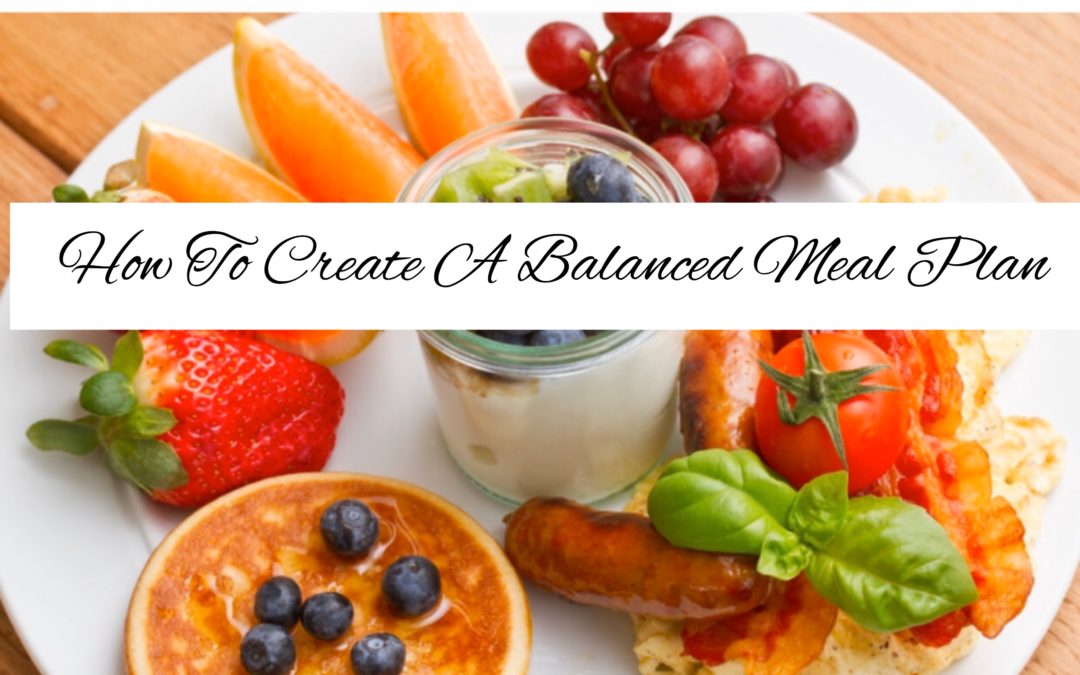Eating a balanced diet is key to being well-nourished, feeling fantastic and maintaining a healthy body weight – for life. Learn how to build a balanced meal plan.
Disclosure: This post contains some affiliate links. If you click on the link and make a purchase, I may earn a commission at no extra cost to you. You can review my full disclosure policy here.

Dietitians are always talking about balance- balanced meals, balanced eating, balanced life. Yet, even with all that talk, people still fall for fads that lack balance, encourage deprivation and ultimately leave you feeling like a failure for not being able to follow through. within the medical community we see experts joining the fight on how food impacts health. And don’t get me started on celebrities or those trying to be!
Opinions on which evil ingredient to blame are endless. While one person claims dietary fat will kill you, another is shouting that sugar is toxic. Another says it’s gluten, but others are sure it’s all of the meat we devour. Food additives, food colors, carbohydrates, soy, pesticides, GMO’s …… the list goes on and on. If you remove every potential culprit claimed to be causing obesity or other health problem from your diet, you’d likely die of starvation or stress before any complication from food.
That’s not to say that some people don’t benefit from food elimination; food allergies and intolerances do exist. But, our countries’ obsession with accusing one nutrient or ingredient as the cause of illness or obesity has created mass confusion in the nutrition world.
Does that sound like health? Not to me. In fact, it sounds physically, mentally and emotionally draining.
If you suffer from fatigue or simply don’t feel right, it certainly could be one a food. However, before you pick up the next best-selling diet or cling to the latest trend claiming to save your life, stop and evaluate your day-to-day eating pattern by keeping a 1-week food journal. You might be surprised what you see.
What Is An Eating Pattern?
Eating pattern refers to the foods you choose to eat on a regular basis, how much of them you eat at one time, and when you eat them. Consider the following questions:
- What foods do you choose to eat as part of your typical day-to-day diet? When you open your refrigerator or cabinet, what do you see? Are fruits and vegetables included at each meal? Do you eat a variety of foods? Do you graze on random items all day or sit down to meals? Does the quality of your food chooses cross your mind when choosing foods? Or, do you eat based on taste preference? Are you willing to change your habits to feel better?
- How much of those foods do you eat? What do your portion sizes look like? Do you eat a small breakfast, quick lunch, huge dinner, then insist on snacking at night? If so, think about why you eat that way? Is it your habit or how you’ve always eaten? Or, maybe it’s lack of time or laziness? Do you base it on your hunger and satiety? Are you willing to change your habits to feel better?
- When do you eat? Do you skip breakfast or wait until your get to work to fuel your body? Do you eat dinner late or early? Are your meal times based on when you are hungry or when you have been told to eat? Are you willing to change your habits to feel better?
More often than not, feeling fantastic and being well-nourished can result from focusing on balanced eating and eating patterns- not dieting and food elimination. The piece of chocolate cake at a birthday party is not the problem; skipping dinner and eating ½ the cake is!
If you want to feel more energized and live a nourished life, focus on your daily eating pattern. That means eating balanced, nutritious and portioned-controlled meals, multiply times a day; it also means including your favorite treats on occasion. Or, for my fellow chocoholics, learning how to fit some chocolate in daily, without feeling any guilt at all what so ever!
That all sounds great, right? But, before you can build balanced meals, you need to understand what balanced means. I’m going to explain right now.
What Is Balanced?
Balance is a vague term. By definition, it means arranging in good proportions; taking everything into account; fairly judged or presented. When discussing food, it refers to having different elements in the right proportions. I like that definition!
Many dietitians hate the term balanced because it can be misunderstood; and they’re right. Just look to the latest fad diet, the IIFYM (if it fits your macros) diet, as an example. That diet is all about counting macronutrients- carbohydrates, protein and fat- to fit into a daily plan. If planned properly, the result is an eating plan balanced in macronutrients. I agree that a balance of macronutrients is important, but is counting how many grams of macronutrients you eat every day the right way? And is it enough? No, it’s not.
Balanced eating means paying attention to your whole diet; the pattern of eating that you follow most often. It’s caring not only about macronutrients, but the micronutrients and phytonutrients that you get from food. It’s also the looking at your portion sizes and meal timing. Let me explain what I mean to make this easier for you to understand.
Macronutrients
Part of balanced eating includes balancing macronutrients- carbohydrates, protein and fat- at each meal, multiple times a day. Doing so helps reduce food cravings, maintain satiety, keep blood sugar levels stable, improve energy levels and feel better.
Here are a few examples of meals balanced in macronutrients:
- Grilled chicken (protein) with a sweet potato (carbohydrate) and broccoli drizzled with olive oil (carbohydrate, fat, phytonutrients)
- Baked breaded chicken baked (carbohydrate, protein and fat) with broccoli (carbohydrate, phytonutrients)
- Steak (protein and fat) served with whole grain rice (carbohydrates) and carrots drizzled with olive oil (carbohydrates, fat, phytonutrients)
- Eggs mixed with vegetables (carbohydrate, protein, fat, phytonutrients) and a slice of whole grain toast (carbohydrate)
- Turkey Sandwich- bread (carbohydrate), turkey breast (protein), slice of cheese (protein and fat)
Read chapter 8 of Fueling Young Athletes for a step-by-step guide on how to build a balanced meal plan.
Macronutrients is one piece of the balanced eating puzzle, but it doesn’t stop there. If you want a balanced, adequate eating plan, you’ll need to pay attention to micronutrients too.
Micronutrients
A balance of macronutrients alone does not equate to a balanced meal plan. A nutritious meal means choosing macronutrients that are filled with vitamins, minerals and phytonutrients. That means choosing carbohydrates, lean proteins and health fats that are nutrient-rich.
Here is an example using carbohydrates. Let’s assume that 30 grams of carbohydrates per meal is an appropriate amount for you. You can get those 30 grams of carbohydrate in a variety of ways, some more nutritious and balanced than others. Let me share a few breakfast options:
- Coffee with 2 tbsp. of sugar= 30 g carbohydrates
- 1 Pop Tart Pastry= 35 g carbohydrates
- ¾ cup blueberries mixed into a container of Greek yogurt= 30 g carbohydrates
- ½ cup cereal with 1 cup skim milk= 30 g carbohydrates
All four ‘meals’ provide ~ 30 grams’ of carbohydrates, but the 3rd and 4th options are balanced in protein, and offer a variety of vitamins, minerals and phytonutrients. You will find that the more nutritious your choices, the better you feel.
Click to see What 400 Calories Looks Like – from balanced meals versus lower-nutrient foods.
Portion Control
Another part of balanced meal planning is portion control. Eating too much at one time, even if it is a perfect balance of high-quality macro and micro-nutrients, can leave you feeling awful. I can’t tell you what the right portion of food for you is, because it varies for all of us. I eat way more than a six-year old child but significantly less than most teenagers I work with. Pay attention to the hunger and satiety cues your body sends. Eat if you are hungry; stop eating when you are full. Avoid waiting so long to eat that you are starving; never stuff your body so full you feel pain. This is not an easy thing to learn. IN fact, many dietitians specialize in helping clients learn to eat this intuitively.
Finding balance is not easy – it takes practice. Just as balancing your finances is a learned skill, so is balancing your meals. But if you follow this advice, you will feel more energized, positive and happier about how you treat your body.
What do you think? Are you ready to commit to balance? Share your thoughts or story on your struggles or success with finding balance in your eating.


 Hi, I’m Heather – a registered dietitian, busy mom, consultant, adventure junkie and travel addict who has mastered living healthy on the go. My blog is where I share simple recipes and healthy living tips to help and inspire others to live their best life.
Hi, I’m Heather – a registered dietitian, busy mom, consultant, adventure junkie and travel addict who has mastered living healthy on the go. My blog is where I share simple recipes and healthy living tips to help and inspire others to live their best life.
Hey Heather, I have an 15 year old athlete, he has the worst eating habits, mainly because he has a texture issue with so many foods, as young as 3 he would gag and throw up from the texture of different foods. He will eat chicken, fried. Bacon, pbj sandwich. That about the only protein! He doesn’t eat beef, pork, seafood. Veggies are limited to carrots. Fruits, bananas, watermelon, apples. His favorite meal is cheese pizza light sauce. String cheese he likes. I make him drink premier protein drinks, which is just one kind, banana. Of course.. he eats a ton of junk… goldfish, chewy bars,chips, candys.. just to fill him up!!! I’ve tried good healthy options and he just can’t seem to eat them…. Oh he does eat some yogurts!… what can I do to help him??